| . 1 . 2 . 3 . >> |
| Author |
Message |
Sarahax
Member
|
# Posted: 20 Jan 2014 07:27pm - Edited by: Sarahax
Reply
We are just at the start of our cabin project. Four years ago we bought 15 acres of woodland in Sussex, and last year were lucky enough to secure the adjoining 15 acres - so 30 in total. England is a crowded country and our wood is not remote. It's only 3 miles to the nearest town - which brings both advantages and problems. However, our wood is part of a much larger forest, so it is usually peaceful. It's classified as 'ancient woodland' - which just means that the site has been continuously wooded since before 1600. In the Middle Ages it was a site of early iron workings. The early iron-workers dammed the stream to make a long pond in the valley and made charcoal from the surrounding trees to fuel the furnace. All that stopped about 350 years ago, but you can still see where they burned the charcoal.
We plan to build a log cabin on a point overlooking the pond. We have quite a lot of unwanted Scots Pine - the remnants of a plantation planted c 50 years ago by the Forestry Commission. The better trees are c 60ft tall, straight and 14" in diameter. The cabin's only going to be small - 4m x 4m, and we'll use it for occasional overnight stays and for sheltering in the warm with a cup of tea. We got planning permission from the local district council on the grounds of 'permitted development'.
Neither of us are builders - don't have the skills or the strength - so we went looking for someone to help. Building log cabins is not an English thing to do - but there is a long tradition in Eastern Europe. Since 2003 some 600,000 Poles have come to live in England so we contacted our local Polish club, who put us in touch with a builder who made traditional log homes in the mountains of southern Poland before coming to England. He was initially quite bemused, but is now enthusiastic and is driving back to Poland next month to pick up his log tools and some traditional Polish chinking material and a woodburner (he was horrified by English prices). I am currently arranging with a forestry contractor to have the selected trees felled and moved to the cabin site. So it should be all go next month! If all goes well we'll have a traditional Polish cabin - in Sussex.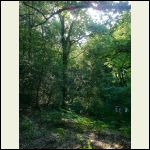
Oak at the edge if the pond
| 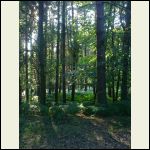
Pines to be felled
| 
The ride
|  |
|
|
ShabinNo5
Member
|
# Posted: 20 Jan 2014 07:51pm
Reply
Welcome to the forum.. What a great project. Looking forward to more pictures.
|
|
bldginsp
Member
|
# Posted: 20 Jan 2014 09:11pm - Edited by: bldginsp
Reply
Wonderful project, beautiful location. Remember not to kill the king's hinds, it's illegal. Correct me if I'm wrong but years ago I think it was illegal to fell trees on the king's land, an equally odious crime. However, having sworn an oath of fealty, one could cut one very large tree to use in the construction of a house, so I hear. But those days are long gone, I suppose.
I recently cut about 50 trees on my property in California to use in the construction of my cabin roof (not walls). I discovered that I had to be very careful which trees I selected to cut, because trees with left hand spiral grain are not usable for construction. They have much less strength when spanning and will tend to twist if in a wall. So, I had to reject a dozen or more logs I had cut and peeled because they showed excessive left hand spiral grain. I'm sure your Polish builder will know which trees to use and which not, and perhaps you have consulted with him on this already, but if not, I suggest you do before cutting. I resorted to peeling enough bark on standing trees to tell their grain spiral direction before cutting them, and left several standing, wound and all, because had I cut them I could not use them.
|
|
old old buddy
Member
|
# Posted: 22 Jan 2014 08:11pm
Reply
Sarahax
Welcome to the forum as well. I have befriended a man from Moscow Russia and now I see that we have some of "The Queens People" on our forum. It's really quite remarkable to talk to people on other continents and find out by photos and such, that we're all just about the same. We all like solitude and the wilderness!
I have said this many times. The cabin is and has been the single most enjoyable thing I have ever done and it was a great father/son project. I'm 62 years old and have been working the property for the past four years. Most of the building was done in 2011 but we had quite a bit of site prep work to do first. We sit about 1168 feet above sea level on a fairly steep hill. I absolutely love it ....as I'm sure you will. Good luck...take hundreds of pictures and start yourselves a cabin "journal" as soon as the construction begins. You'll never regret it. I'm Old Old Buddy and my son is Old Buddy. ....as I'm sure you will. Good luck...take hundreds of pictures and start yourselves a cabin "journal" as soon as the construction begins. You'll never regret it. I'm Old Old Buddy and my son is Old Buddy.
OOB
|
|
MtnDon
Member
|
# Posted: 22 Jan 2014 08:42pm
Reply
info on spiral grain...
trees start out left handed but most switch to right hand as they get older. That balances out the internal stress. But some do not change and those are the ones that make great firewood. 
|
|
bldginsp
Member
|
# Posted: 22 Jan 2014 10:56pm
Reply
or beams in a woodshed as an experiment to see if they'll fail the first heavy snow
|
|
creeky
Member
|
# Posted: 25 Jan 2014 11:12am
Reply
beautiful pics. looking forward to your build.
|
|
dws
Member
|
# Posted: 25 Jan 2014 11:46am
Reply
The left hand spiral is interesting to me as I am looking for someone to come and fall my trees to begin on my cabin. So any more info would be a great help! You talk about striping back enough bark to be able to tell which way the spiral goes. I hate to cut more trees than need be.
|
|
|
tnky03
Member
|
# Posted: 25 Jan 2014 06:27pm
Reply
Sarahax, your property sounds awesome! What interesting history surrounding your future cabin site. Welcome to this forum.
|
|
toyota_mdt_tech
Member
|
# Posted: 25 Jan 2014 07:04pm
Reply
Sarahax, pretty country, looks lots like the Northwest. Hey, preserve those precious oaks too.
Looking forward to the cabin project pictures. Keep us posted along the way.
Build it big enough, its hard to add onto a log cabin and make it look nice/right. Do it big enough from the beginning.
|
|
Just
Member
|
# Posted: 25 Jan 2014 07:22pm
Reply
what's the weather like in Sussex this week ,hopefully warmer than Canada.
|
|
bldginsp
Member
|
# Posted: 25 Jan 2014 08:04pm - Edited by: bldginsp
Reply
dws- I learned about the issue of spiral grain when researching how to use logs in construction, when reading Robert Chambers book, Log Construction Manual. He will refer you to the Int. Log Builders Assoc. and their standards for log construction.
I had to reject 25-30% of the logs I initially cut because I discovered after they began to dry that they were badly left spiraled. I should have been more careful as I first began to cut and peel logs (it was in 10 degree weather, but that's another story).
So later I resorted to very carefully checking trees before I bothered to even take them down. With a spokeshave, I peeled back bark leaving an area of bare wood about 3 x 12 inches. Then I pulled a peeling of wood about 8 inches long, but left it attached at one end. Then I took the peeling in my fingers and split it lengthwise by bending it. This showed me the true grain direction. Then I pulled the split peeling up back into alignment with the tree to see how the grain direction compared with the centerline of the tree. If more than one in 30 spiraling left, I rejected it. Left it standing, wound and all.
Read Chambers book. He'll tell you more, and he gives the best set of instructions for log construction I've ever seen. There's a lot more to it than cutting notches. And, send us photos.
|
|
Sarahax
Member
|
# Posted: 2 Mar 2014 03:09pm
Reply
Hi everybody
Thank you for your warm welcome to the small cabin forum. It was great to hear such enthusiasm from fellow cabin builders. I thought I would give you an update on progress.
We signed the contract with Kris, our Polish builder, at the beginning of February and work began on 10th Feb. Kris and his team began digging the foundations - all by hand, can you believe it? The geology is a mixture of sand and clay - quite soft, so the foundation needed to be deep. Six builders bags of ballast and a pallet of cement were delivered to the gate and then tractored down the ride, but still needed to be wheelbarrowed down to the site itself.
At the same time 40 of our largest straightest pines were felled. In retrospect, starting this at the end of the wettest winter since records began (we've had over twice the usual rainfall) might have been a bit optimistic. With the water table literally squelching under our boots the wood is now mud city. However it hasn't stopped Mariusz and Piotr who have been stripping the bark from the felled trees. This too is done by hand the traditional Polish way. They were keen to do this as soon after the trees were felled as possible while the bark was comparatively easy to remove. Here's a photo of the tool they were using.
The foundations are now finished and the concrete set on a couple of dry days. The tractor was in today to move the felled logs into a convenient position for the build. Yes it rained again.
All of this has inspired me to sign up for a chainsaw course at our local college. Until now I've been quite nervous around chainsaws, and I still don't know whether I will either have the nerve, or more importantly the physical strength, to use one effectively and safely. I'm only 5' 4". So I'll find out next month. The college has said they will lend me the protective clothing, but I need to bring my own boots. Ordered off the Internet, these are amazingly heavy, weighing in at nearly 1Kg each. I'll let you know how I get on.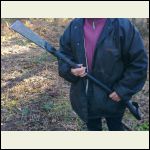
Bark removal tool
| 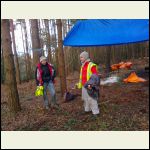
Mariusz and Piotr - traditional log cabin builders
| 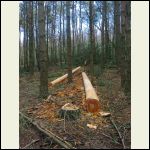
Stripped logs
| 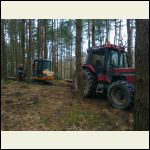
Tractor moving logs
|
|
|
silverwaterlady
Member
|
# Posted: 2 Mar 2014 04:45pm
Reply
Will your cabin be hand scribed? I have a thread on here "Our log cabin". We had a hand scribed cabin built in Canada.
|
|
Just
Member
|
# Posted: 2 Mar 2014 07:09pm
Reply
No snow in the bush !!What's with that ???
|
|
adakseabee
Member
|
# Posted: 3 Mar 2014 06:23pm
Reply
The bark removal tool shown in the photo is called a spud. I'd be interested to know what the Polish word is for that tool.
|
|
Sarahax
Member
|
# Posted: 11 Mar 2014 01:07pm
Reply
It has finally stopped raining and Spring has arrived. Sun is out and first brimstone butterflies have appeared. The wet weather meant that there was a delay before David the forester could move the final logs into position. Meanwhile Kris and team got the first two log courses in place. The final logs were moved five days ago and the log work is now really moving.
Those logs are really heavy. We reckon there's about 30 tons of timber in that cabin. The beam they are all hauled up on is a small felled pine lashed to two others. What worries me is that one of the trees supporting it is dead.
Meanwhile we're sourcing the rest of the materials as we go. The extra wood for the construction has been ordered and is being delivered tomorrow. We wanted an inward opening window to accommodate the outside shutters. You can't buy these off the shelf in England as English windows open outwards, so I've ordered one from a French builders merchant and will go over to Calais on the ferry to pick it up in a couple of weeks.
The roof is more tricky and has been the subject of much discussion. Although I'd love chestnut shingles, you might as well budget for roofing the cabin with gold leaf. Kris suggests using good quality roofing felt to ensure it's waterproof and then using other wood to clad this purely for cosmetic purposes. In the wood itself we have lots of birch and scots pine. I would love to use some of this as the roofing cladding material, but neither are not very durable. I could hire a mobile sawmill and mill some birch into planks - but would they last as roof cladding? Is this a silly idea? Would be interested to hear what you think.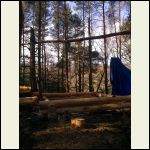
First logs in place
| 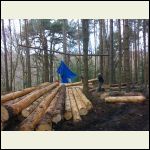
Kris - in hat - positioning log. Note the beam that is taking the weight!
| 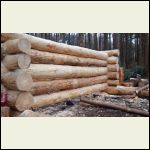
Cabin progress 8th May
| 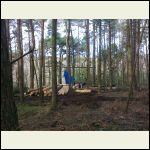
Overview of site
|
|
|
bldginsp
Member
|
# Posted: 11 Mar 2014 02:16pm
Reply
What do you mean by 'roof cladding'? Do you mean wood boards over the felt waterproofing layer?
|
|
Sarahax
Member
|
# Posted: 11 Mar 2014 02:46pm
Reply
Yes - that's the kind of thing I mean
|
|
bldginsp
Member
|
# Posted: 11 Mar 2014 02:58pm
Reply
I have never heard of such a means of roofing, but perhaps that is just a measure of my ignorance. I can see plenty of potential problems using boards as a finish roofing material over paper. Have you ever seen this method employed, or are you simply trying to figure how to make use of site materials?
|
|
Sarahax
Member
|
# Posted: 11 Mar 2014 03:05pm
Reply
I'm just trying to figure out how best to use the materials I have available which is a lot of birch and scots pine. As I understand it neither are that suitable for making a roof by themselves. So the idea came up of making a waterproof roof out of felt, and then using either birch or pine as cladding, an outer cover which is purely to improve the cosmetic appearance. Do you think there would be problems with this? What do you think? If this isn't a good idea, can you suggest another approach?
|
|
bldginsp
Member
|
# Posted: 11 Mar 2014 03:26pm - Edited by: bldginsp
Reply
Good idea in principle, but each piece of cladding must be nailed down, and these penetrations through the paper will cause leaks. In the old days of log cabins they split shake shingles out of site woods using a froe, and a skilled roofer can lay such shingles not to leak without paper. But the standard method of applying shakes now is with layers of paper between each course of shake. If you are determined to use site materials for your roofing rather than purchase standard roofing materials, I suggest you consider getting a froe and splitting your own shakes, and install them with paper in the standard manner.
What do your Polish builders suggest?
Please send more photos of your surrounding countryside if you have them, the few you posted are extraordinary.
|
|
bugs
Member
|
# Posted: 11 Mar 2014 04:29pm
Reply
Hello Sarahax
Love your story....so far.
We have spent many a wonderful holiday in Sussex and environs. We have relatives in East Grinstead and have explored a far bit of the area. We have relatives in East Grinstead and have explored a far bit of the area.
Glad to hear the rain has stopped. It was a WET winter for your area.
Good luck with your build.
bugs
|
|
PatrickH
Member
|
# Posted: 11 Mar 2014 05:39pm
Reply
You will not want to use birch or pine for roofing neither species has any natural decay resistance, Usually cedar shakes are used for roofing. What about a traditional thatch roof as I understand there are still some quite capable thatchers in your area. And I also understand there is a different material some use for the thatch that is more sustainable. And they look really cool!
|
|
Sarahax
Member
|
# Posted: 16 Mar 2014 08:04pm
Reply
Thanks for all the advice. We have now ruled out birch and pine. Thatch would be lovely but very expensive and you need to book a thatcher about two years in advance. They do exist round here but are much in demand.
We are probably going for brown galvanized corrugated roofing sheets which I believe are popular in the States as cabin roofs. Couple of reasons for this - cheap and practical, and also not too prettified. (I would say 'twee' but think this might be an English concept.)
Roof frame now complete and deck made.
|
|
Sarahax
Member
|
# Posted: 16 Mar 2014 08:06pm
Reply
Latest photo of cabin progress 16th March 2014
|
|
Just
Member
|
# Posted: 16 Mar 2014 08:47pm
Reply
maybe you should consider keeping the blue color of the plastic tarp, [when ordering the steel] looks very nice with the blue sky .
|
|
cabingal3
Member
|
# Posted: 16 Mar 2014 09:52pm
Reply
welcome Sarahax-theres lots of encouragment and info on this group.your cabin is so beautiful.i have peeled logs before with a bread knife.was fun but i think your tool is better.
great job.
|
|
Sarahax
Member
|
# Posted: 24 Mar 2014 08:25pm - Edited by: Sarahax
Reply
Hello all and especially hello to Bugs. If you're familiar with East Grinstead then you'll know the type of area we're in. East Grinstead is only about 15 miles east of our cabin site. Countryside is really pretty there too.
Thought I would post some photos to show progress and introduce the team of cabin builders. As per last post we are going to go with a tin roof - and have ordered green corrugated metal sheeting. These photos show Kris, Henry and Piotr finishing putting the breathable waterproof membrane on the roof, which is the final layer before the sheet goes on.
Kris (in grey hat) is a real craftsman and the man in charge. He's been in England for 10 years, and made log homes in Southern Poland before coming here. At first we didn't know quite how to take him, as he doesn't talk a lot, and initially we communicated mainly by drawing. Mind you, he probably didn't know how to take us either, as this is an unusual project for Sussex. But as the cabin takes shape he is immensely pleased with it and we trust him.
Henry (taking photograph) is a carpenter who had obviously worked on log homes before. We don't know a lot about him, as he speaks very little English. But he's usually the man who will come up with the solution to any problem.
Piotr (red jacket) is the labourer, whose job is to fetch and carry stuff. Our ride still remains wet muddy and impassable, so Piotr spends a lot of time barrowing stuff from the entrance gate to the site.
They work strict hours, arriving at seven and finishing at three in the afternoon. Although it's early Spring 9 degrees C (48F) at midday it's damp and cold in the morning so they've generally got a fire burning as you can see in the last photo.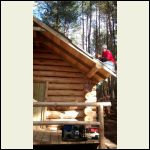
Piotr trimming the roof membrane
| 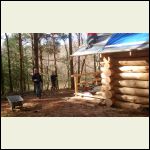
Kris, Henry - taking photo. Pond in the background
| 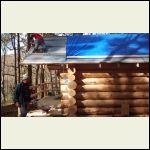
Kris on site
| 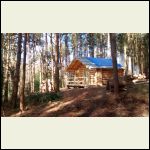
Cabin with post and rail fence around deck
|
|
|
bldginsp
Member
|
# Posted: 24 Mar 2014 10:22pm - Edited by: bldginsp
Reply
I'm curious, if I may- what are the sill logs sitting on?
|
|
| . 1 . 2 . 3 . >> |

